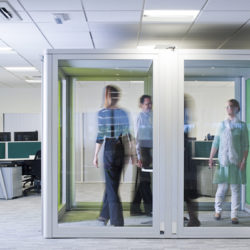Which is the receipt to be a “Smarter Working” company? BBB (Bricks, Bits, Behaviour).
According to Plantronics, the application of Smarter Working today creates: reduction of 30% of costs of real estate, decrease of 60% of absence of employees, increase of 20% of happiness of staff and clients (Plantronics Leesman Index Study 2011). For this reason Plantronics,global leader in audio solutions for communications, is the first company that has promoted “Smarter Working” philosophy, together with a key partner as Smart Working Observatory of School of Management of Politecnico of Milan.
(The next WOW! webmagazine will publishan article about the researchof the School of Management of Politecnico di Milano with exclusive interviews)
Which is the receipt to be a “Smarter Working” company?
Bricks, the evolution of work space;
Bits, implementation of Unified Communication & Collaboration;
Behaviour, new ways to manage the team.
“The tradition office is evolving – explains Philip Vanhoutte, Senior Vice President and General Manager EMEA of Plantronics – Professionals today need right tools to meet their needs and to increase the productivity, to promote the innovation and to improve the collaboration. We believe that our products give people the freedom to work in a more effective and cost-effective way, so that people can communicate simply, no matter where they are, at home, office or travelling.”
The Smart Working Observatory was created to monitor and interpret this phenomenon, and to outline the possible directions for action. In its first year of activity, the Survey involved a variety of actors in Italy:
65 Human Resource Managers
88 Chief Information Officers (CIOs), representing Italian companies of medium to large size, through surveys and direct interviews, to understand investments and the development prospects of ICT technologies in Smart Working, such as Unified Communication & Collaboration, Social Service & Community, Applications and Mobile Devices, Cloud Computing;
80 Managers and Executives of Business Lines, to analyze the trends and need for improvement of work patterns and styles in terms of culture and management & employees’ behaviours, policies and organizational rules, physical work space (office) and virtual work space (ICT tools);
1000 subordinates (employees/managers/executives) of medium to large companies aged between 16 and 65, through a survey made in collaboration with Doxa [Italian market research company] to analyze their ways of working and related satisfaction, as well as the use and impact of ICT tools on their performance.
Bricks (“Physical” Work Space): Collaboration, Openness, Flexibility and Wellbeing of the Workers
As regards the first lever needed to define a Smart Working System (Bricks), the Survey has shown that, in recent years, many Italian companies are reviewing the concept of physical work space: 39% of HR Managers stated that, in their company, annual or long-term plans to redesign the layout of the offices were defined with the aim of creating open and flexible environments, aimed at the collaboration and wellbeing of people. In addition, 58% of the sample stated that they have already made significant changes and innovations in this area in the past.
“Simply Smarter office is not only about redesigning the office. Today there are new ways to work and the employees spend more and more time far from their desk. With this increasing trend – adds Philip Vanhoutte – it emerges the need of the companies to provide to their team the necessary space to work and to have the proper tools. Today the Simply Smarter office have to consider the needs of all workers, that are more cost-effective if they work in ways that improve the productivity.”
Bits (“Virtual” Work Space): Diffusion of the Main ICT Applications and Devices
Along with the redesign of physical space, it is also necessary to act on the level related to virtual work space (Bits), which is a set of tools and ICT devices that are increasingly more used by people as an essential tool to carry out their work activities
Beyond the explicit investments made by companies, Smart Working enabling tools are becoming more and more widespread also thanks to the phenomenon of consumerization. As far as devices are concerned, in 59% of the companies employees use their personal devices (personal computers, smartphones, New Tablets) to work.
Actually, it emerges that only 13% of the companies altogether developed advanced Smart Working patterns, thus creating complete “virtual spaces” for most employees.
Behaviour (Organizational Policies and Work Patterns): beyond the Boundaries of Space and Time
The last lever considered in the Survey, which is significantly influenced by organizational policies, refers to culture and organizational behaviours in relation to work patterns (Behaviours). As far as this aspect is concerned, the HR Managers interviewed say that only in 5% of the companies all workers can choose how to allocate their working time among different work places (home, office, at customer sites, etc.), while in 38% of cases this possibility is only offered to certain types of employees. In particular, telecommuting (work from home) is practiced by less than 10% of the workforce, typically salesmen, managers, and women with families.
The reasons for this limited flexibility:
Coordination and collaboration difficulties among the employees (56%)
Fear of loss of control by a management that is poorly oriented to delegation and work to targets (50%)
Risk associated with the fear of isolation and estrangement of people (47%).
Today the management is committed on themes about Smart Working, but it had some difficulties in sharing company information and to promote the contribution of people.
Today employees are not so available to change the ways they work and to redefine the activities, working in a flexible way (place and timing), based on needs. This is the opposite of what emerges from the analysis of final users, that motivated by management e by company policy, declare to be available to adopt new work models.
Is your workplace smart?

















